Used Car Purchase Negotiation: Strategies and Tactics Report
VerifiedAdded on 2023/04/25
|7
|1584
|253
Report
AI Summary
This report provides an analysis of negotiation strategies employed during the purchase of a used 2014 Ford Escape SE from Kentwood Ford Used Car Supercenter in Edmonton. It examines the perspectives of the dealer, the buyer, and an observer, highlighting the negotiation fundamentals, including the determination of Least Acceptable Statements (LAS) and the management of conflict. The report details the tactics used by both parties, such as the seller's attempts to add additional costs and the buyer's insistence on a warranty and direct communication with the dealer. It concludes with recommendations for improving the negotiation process, such as researching the dealership's cost, avoiding premature concessions, and considering a neutral third party. The negotiation ultimately resulted in a mutually agreed-upon price, showcasing a win-win scenario, with potential strategies for future negotiations also discussed. This assignment is available on Desklib, where students can find a variety of study tools and solved assignments.
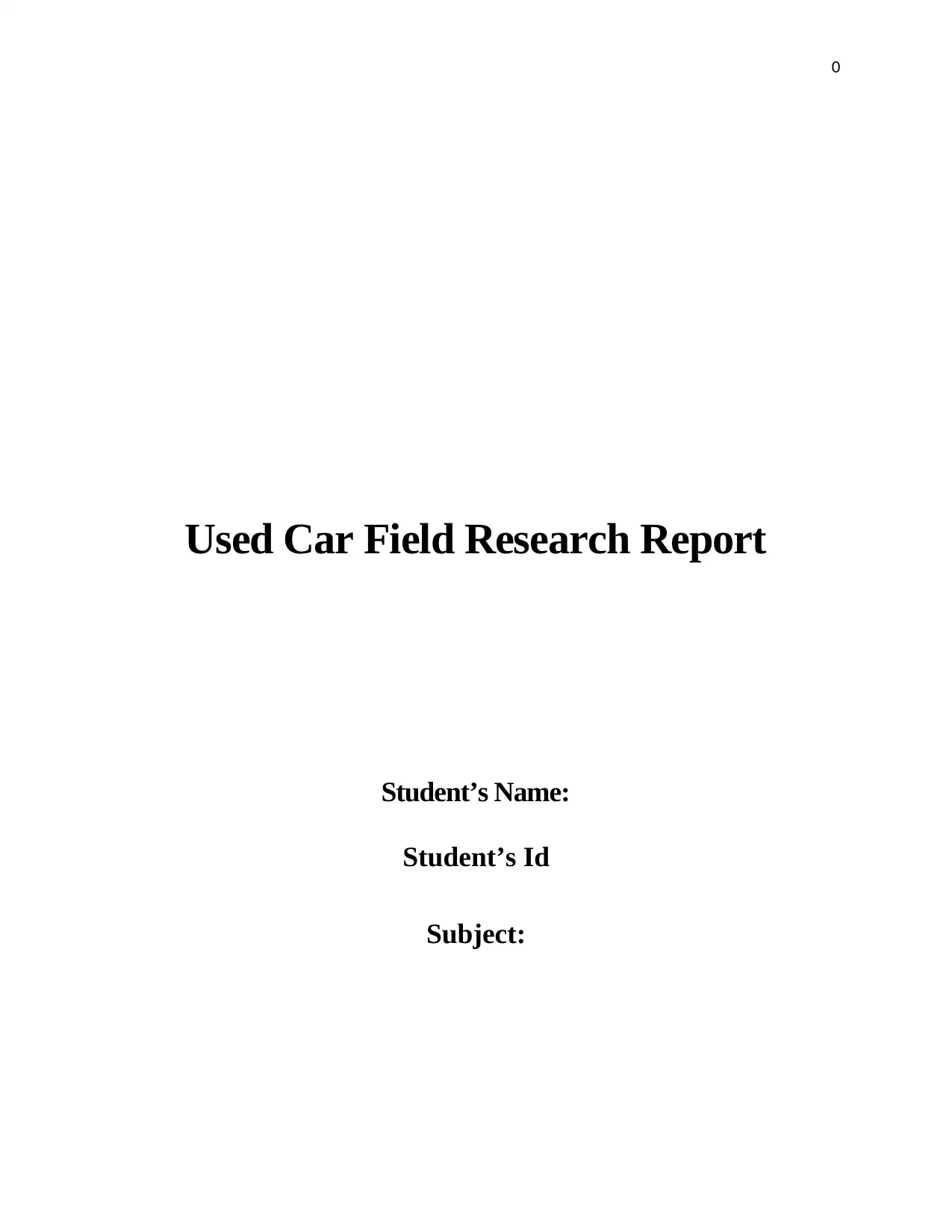
0
Used Car Field Research Report
Student’s Name:
Student’s Id
Subject:
Used Car Field Research Report
Student’s Name:
Student’s Id
Subject:
Paraphrase This Document
Need a fresh take? Get an instant paraphrase of this document with our AI Paraphraser
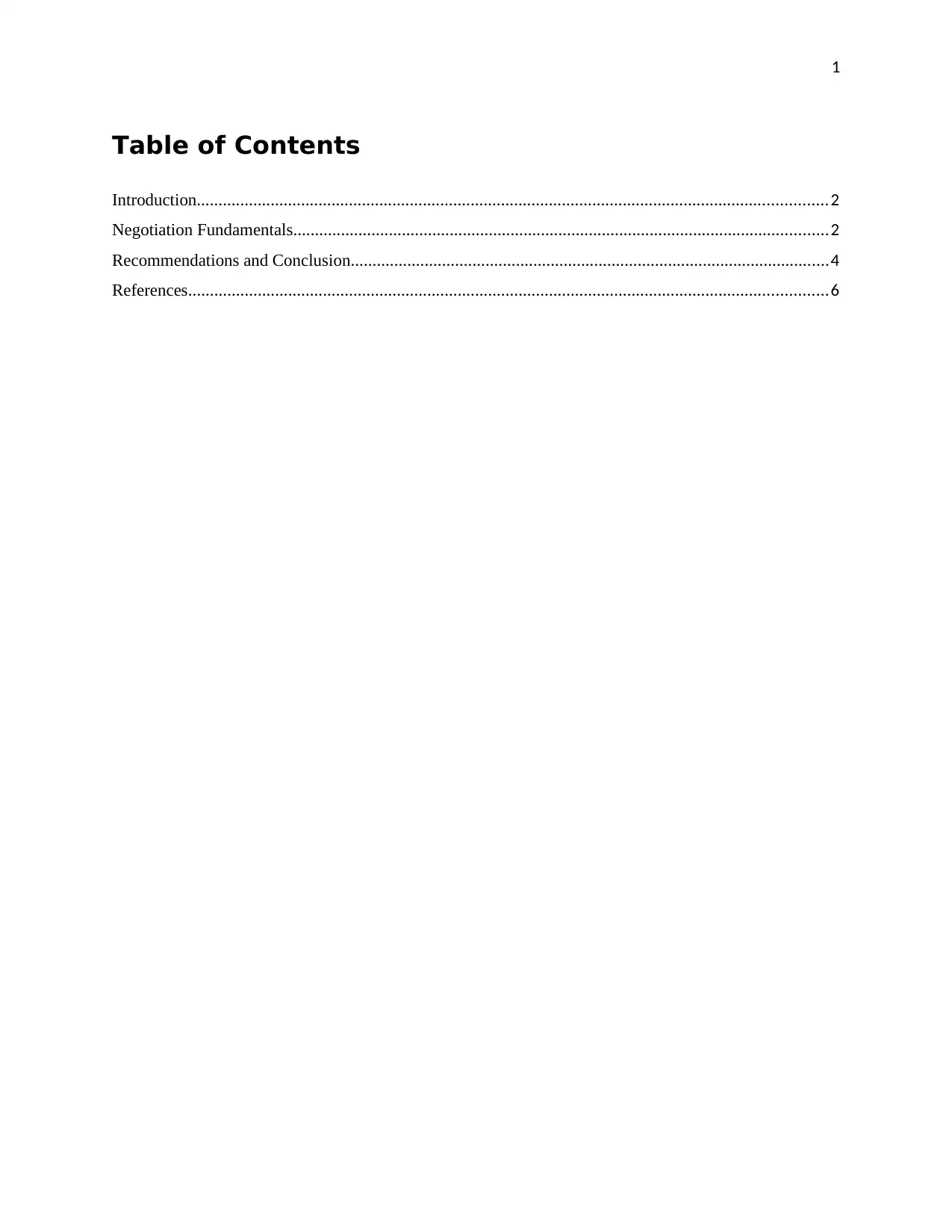
1
Table of Contents
Introduction.................................................................................................................................................2
Negotiation Fundamentals...........................................................................................................................2
Recommendations and Conclusion..............................................................................................................4
References...................................................................................................................................................6
Table of Contents
Introduction.................................................................................................................................................2
Negotiation Fundamentals...........................................................................................................................2
Recommendations and Conclusion..............................................................................................................4
References...................................................................................................................................................6
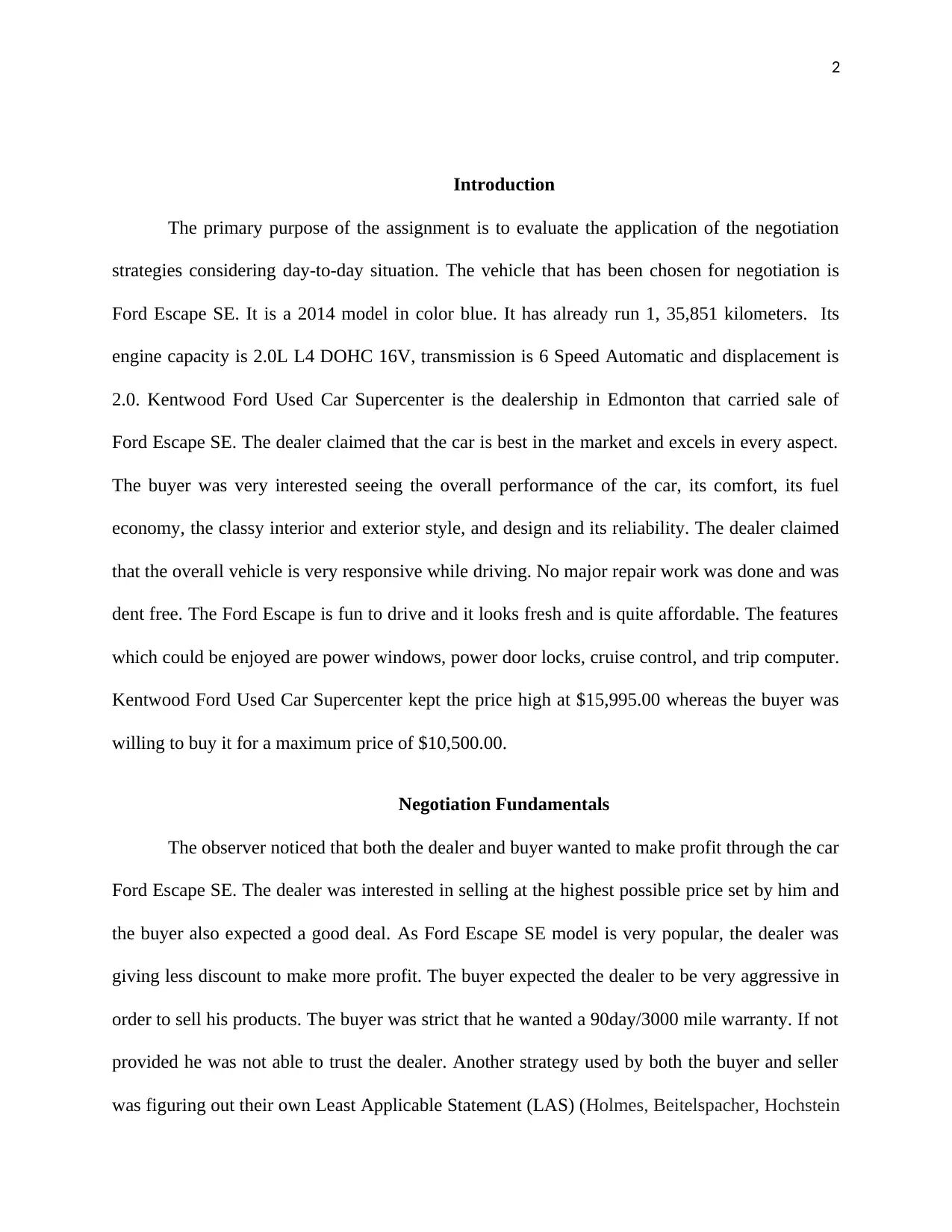
2
Introduction
The primary purpose of the assignment is to evaluate the application of the negotiation
strategies considering day-to-day situation. The vehicle that has been chosen for negotiation is
Ford Escape SE. It is a 2014 model in color blue. It has already run 1, 35,851 kilometers. Its
engine capacity is 2.0L L4 DOHC 16V, transmission is 6 Speed Automatic and displacement is
2.0. Kentwood Ford Used Car Supercenter is the dealership in Edmonton that carried sale of
Ford Escape SE. The dealer claimed that the car is best in the market and excels in every aspect.
The buyer was very interested seeing the overall performance of the car, its comfort, its fuel
economy, the classy interior and exterior style, and design and its reliability. The dealer claimed
that the overall vehicle is very responsive while driving. No major repair work was done and was
dent free. The Ford Escape is fun to drive and it looks fresh and is quite affordable. The features
which could be enjoyed are power windows, power door locks, cruise control, and trip computer.
Kentwood Ford Used Car Supercenter kept the price high at $15,995.00 whereas the buyer was
willing to buy it for a maximum price of $10,500.00.
Negotiation Fundamentals
The observer noticed that both the dealer and buyer wanted to make profit through the car
Ford Escape SE. The dealer was interested in selling at the highest possible price set by him and
the buyer also expected a good deal. As Ford Escape SE model is very popular, the dealer was
giving less discount to make more profit. The buyer expected the dealer to be very aggressive in
order to sell his products. The buyer was strict that he wanted a 90day/3000 mile warranty. If not
provided he was not able to trust the dealer. Another strategy used by both the buyer and seller
was figuring out their own Least Applicable Statement (LAS) (Holmes, Beitelspacher, Hochstein
Introduction
The primary purpose of the assignment is to evaluate the application of the negotiation
strategies considering day-to-day situation. The vehicle that has been chosen for negotiation is
Ford Escape SE. It is a 2014 model in color blue. It has already run 1, 35,851 kilometers. Its
engine capacity is 2.0L L4 DOHC 16V, transmission is 6 Speed Automatic and displacement is
2.0. Kentwood Ford Used Car Supercenter is the dealership in Edmonton that carried sale of
Ford Escape SE. The dealer claimed that the car is best in the market and excels in every aspect.
The buyer was very interested seeing the overall performance of the car, its comfort, its fuel
economy, the classy interior and exterior style, and design and its reliability. The dealer claimed
that the overall vehicle is very responsive while driving. No major repair work was done and was
dent free. The Ford Escape is fun to drive and it looks fresh and is quite affordable. The features
which could be enjoyed are power windows, power door locks, cruise control, and trip computer.
Kentwood Ford Used Car Supercenter kept the price high at $15,995.00 whereas the buyer was
willing to buy it for a maximum price of $10,500.00.
Negotiation Fundamentals
The observer noticed that both the dealer and buyer wanted to make profit through the car
Ford Escape SE. The dealer was interested in selling at the highest possible price set by him and
the buyer also expected a good deal. As Ford Escape SE model is very popular, the dealer was
giving less discount to make more profit. The buyer expected the dealer to be very aggressive in
order to sell his products. The buyer was strict that he wanted a 90day/3000 mile warranty. If not
provided he was not able to trust the dealer. Another strategy used by both the buyer and seller
was figuring out their own Least Applicable Statement (LAS) (Holmes, Beitelspacher, Hochstein
⊘ This is a preview!⊘
Do you want full access?
Subscribe today to unlock all pages.

Trusted by 1+ million students worldwide
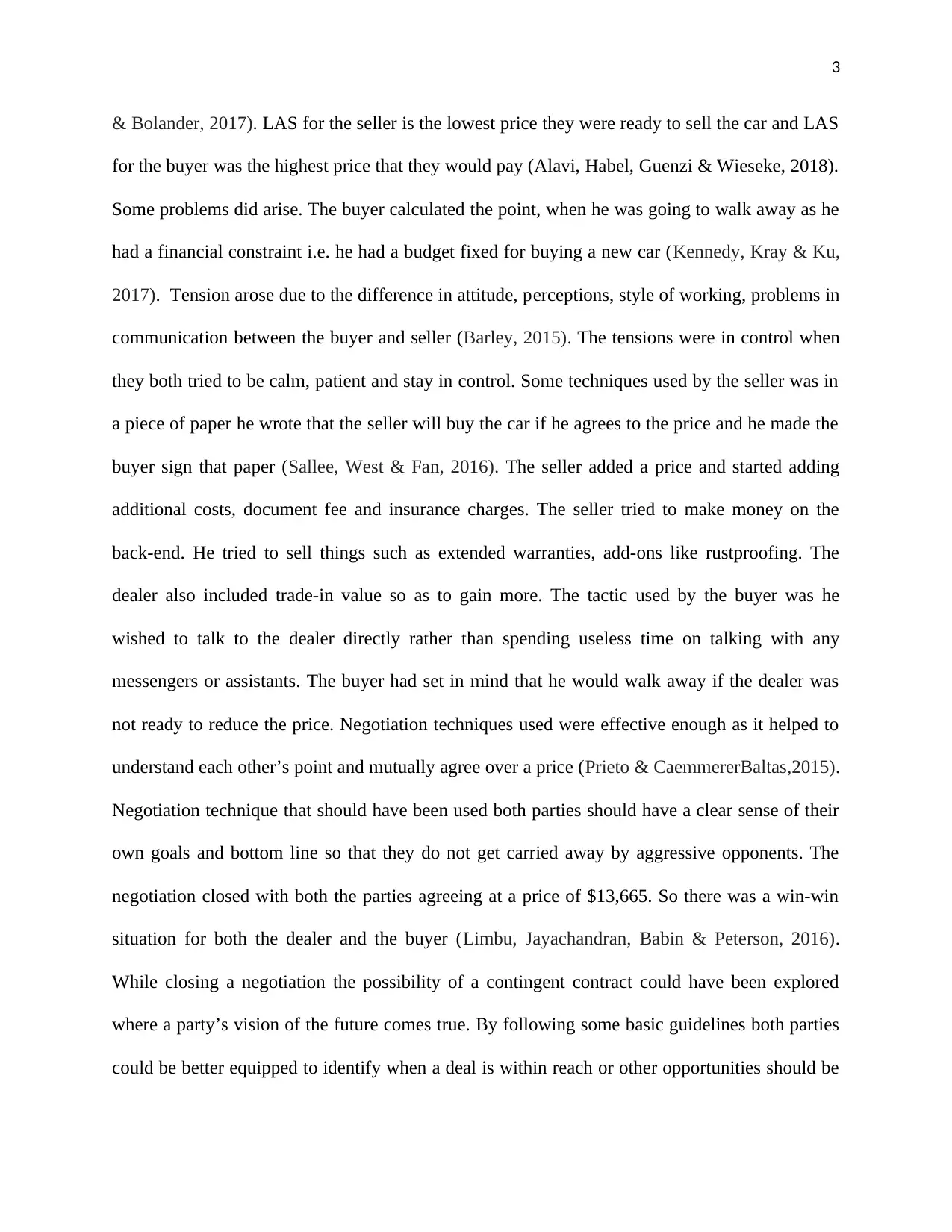
3
& Bolander, 2017). LAS for the seller is the lowest price they were ready to sell the car and LAS
for the buyer was the highest price that they would pay (Alavi, Habel, Guenzi & Wieseke, 2018).
Some problems did arise. The buyer calculated the point, when he was going to walk away as he
had a financial constraint i.e. he had a budget fixed for buying a new car (Kennedy, Kray & Ku,
2017). Tension arose due to the difference in attitude, perceptions, style of working, problems in
communication between the buyer and seller (Barley, 2015). The tensions were in control when
they both tried to be calm, patient and stay in control. Some techniques used by the seller was in
a piece of paper he wrote that the seller will buy the car if he agrees to the price and he made the
buyer sign that paper (Sallee, West & Fan, 2016). The seller added a price and started adding
additional costs, document fee and insurance charges. The seller tried to make money on the
back-end. He tried to sell things such as extended warranties, add-ons like rustproofing. The
dealer also included trade-in value so as to gain more. The tactic used by the buyer was he
wished to talk to the dealer directly rather than spending useless time on talking with any
messengers or assistants. The buyer had set in mind that he would walk away if the dealer was
not ready to reduce the price. Negotiation techniques used were effective enough as it helped to
understand each other’s point and mutually agree over a price (Prieto & CaemmererBaltas,2015).
Negotiation technique that should have been used both parties should have a clear sense of their
own goals and bottom line so that they do not get carried away by aggressive opponents. The
negotiation closed with both the parties agreeing at a price of $13,665. So there was a win-win
situation for both the dealer and the buyer (Limbu, Jayachandran, Babin & Peterson, 2016).
While closing a negotiation the possibility of a contingent contract could have been explored
where a party’s vision of the future comes true. By following some basic guidelines both parties
could be better equipped to identify when a deal is within reach or other opportunities should be
& Bolander, 2017). LAS for the seller is the lowest price they were ready to sell the car and LAS
for the buyer was the highest price that they would pay (Alavi, Habel, Guenzi & Wieseke, 2018).
Some problems did arise. The buyer calculated the point, when he was going to walk away as he
had a financial constraint i.e. he had a budget fixed for buying a new car (Kennedy, Kray & Ku,
2017). Tension arose due to the difference in attitude, perceptions, style of working, problems in
communication between the buyer and seller (Barley, 2015). The tensions were in control when
they both tried to be calm, patient and stay in control. Some techniques used by the seller was in
a piece of paper he wrote that the seller will buy the car if he agrees to the price and he made the
buyer sign that paper (Sallee, West & Fan, 2016). The seller added a price and started adding
additional costs, document fee and insurance charges. The seller tried to make money on the
back-end. He tried to sell things such as extended warranties, add-ons like rustproofing. The
dealer also included trade-in value so as to gain more. The tactic used by the buyer was he
wished to talk to the dealer directly rather than spending useless time on talking with any
messengers or assistants. The buyer had set in mind that he would walk away if the dealer was
not ready to reduce the price. Negotiation techniques used were effective enough as it helped to
understand each other’s point and mutually agree over a price (Prieto & CaemmererBaltas,2015).
Negotiation technique that should have been used both parties should have a clear sense of their
own goals and bottom line so that they do not get carried away by aggressive opponents. The
negotiation closed with both the parties agreeing at a price of $13,665. So there was a win-win
situation for both the dealer and the buyer (Limbu, Jayachandran, Babin & Peterson, 2016).
While closing a negotiation the possibility of a contingent contract could have been explored
where a party’s vision of the future comes true. By following some basic guidelines both parties
could be better equipped to identify when a deal is within reach or other opportunities should be
Paraphrase This Document
Need a fresh take? Get an instant paraphrase of this document with our AI Paraphraser
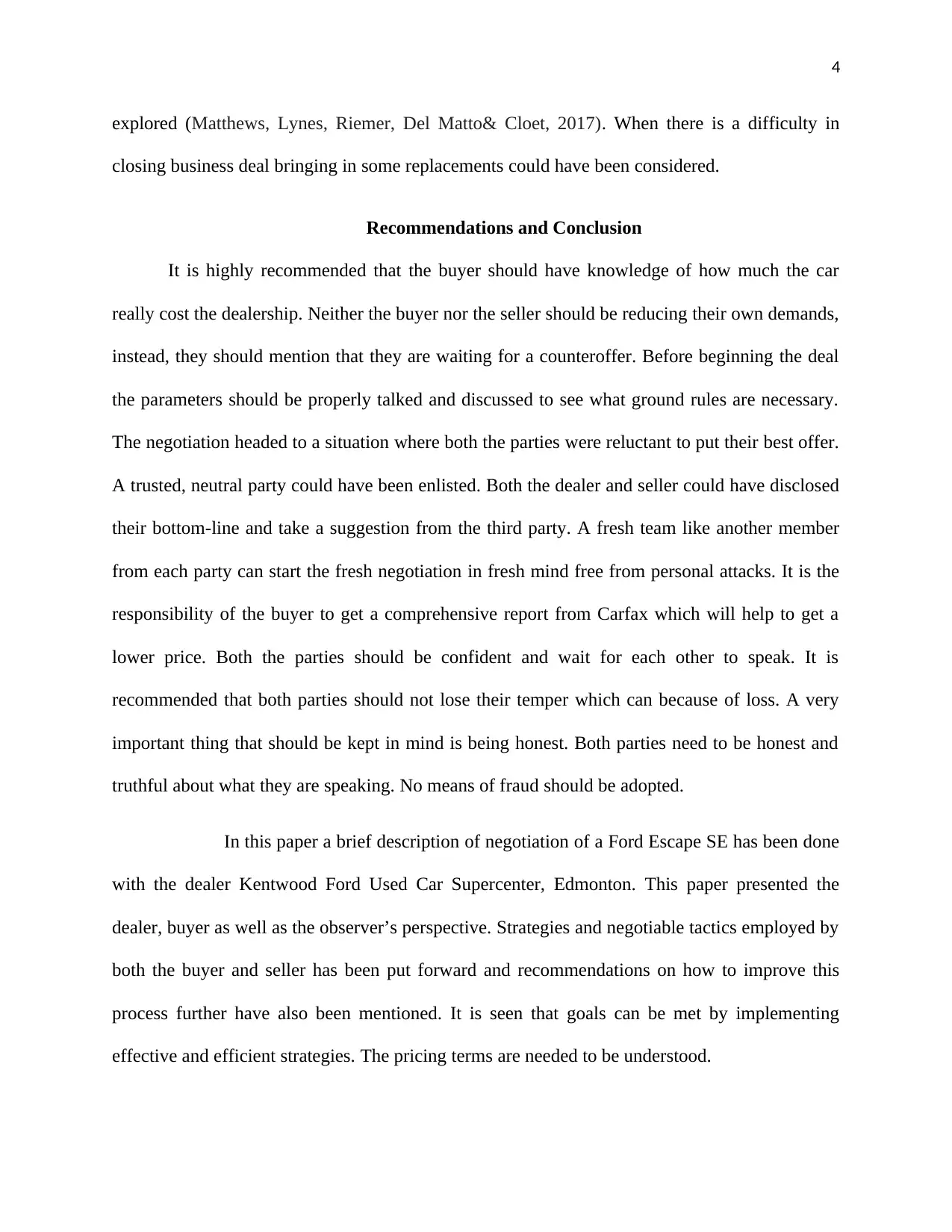
4
explored (Matthews, Lynes, Riemer, Del Matto& Cloet, 2017). When there is a difficulty in
closing business deal bringing in some replacements could have been considered.
Recommendations and Conclusion
It is highly recommended that the buyer should have knowledge of how much the car
really cost the dealership. Neither the buyer nor the seller should be reducing their own demands,
instead, they should mention that they are waiting for a counteroffer. Before beginning the deal
the parameters should be properly talked and discussed to see what ground rules are necessary.
The negotiation headed to a situation where both the parties were reluctant to put their best offer.
A trusted, neutral party could have been enlisted. Both the dealer and seller could have disclosed
their bottom-line and take a suggestion from the third party. A fresh team like another member
from each party can start the fresh negotiation in fresh mind free from personal attacks. It is the
responsibility of the buyer to get a comprehensive report from Carfax which will help to get a
lower price. Both the parties should be confident and wait for each other to speak. It is
recommended that both parties should not lose their temper which can because of loss. A very
important thing that should be kept in mind is being honest. Both parties need to be honest and
truthful about what they are speaking. No means of fraud should be adopted.
In this paper a brief description of negotiation of a Ford Escape SE has been done
with the dealer Kentwood Ford Used Car Supercenter, Edmonton. This paper presented the
dealer, buyer as well as the observer’s perspective. Strategies and negotiable tactics employed by
both the buyer and seller has been put forward and recommendations on how to improve this
process further have also been mentioned. It is seen that goals can be met by implementing
effective and efficient strategies. The pricing terms are needed to be understood.
explored (Matthews, Lynes, Riemer, Del Matto& Cloet, 2017). When there is a difficulty in
closing business deal bringing in some replacements could have been considered.
Recommendations and Conclusion
It is highly recommended that the buyer should have knowledge of how much the car
really cost the dealership. Neither the buyer nor the seller should be reducing their own demands,
instead, they should mention that they are waiting for a counteroffer. Before beginning the deal
the parameters should be properly talked and discussed to see what ground rules are necessary.
The negotiation headed to a situation where both the parties were reluctant to put their best offer.
A trusted, neutral party could have been enlisted. Both the dealer and seller could have disclosed
their bottom-line and take a suggestion from the third party. A fresh team like another member
from each party can start the fresh negotiation in fresh mind free from personal attacks. It is the
responsibility of the buyer to get a comprehensive report from Carfax which will help to get a
lower price. Both the parties should be confident and wait for each other to speak. It is
recommended that both parties should not lose their temper which can because of loss. A very
important thing that should be kept in mind is being honest. Both parties need to be honest and
truthful about what they are speaking. No means of fraud should be adopted.
In this paper a brief description of negotiation of a Ford Escape SE has been done
with the dealer Kentwood Ford Used Car Supercenter, Edmonton. This paper presented the
dealer, buyer as well as the observer’s perspective. Strategies and negotiable tactics employed by
both the buyer and seller has been put forward and recommendations on how to improve this
process further have also been mentioned. It is seen that goals can be met by implementing
effective and efficient strategies. The pricing terms are needed to be understood.
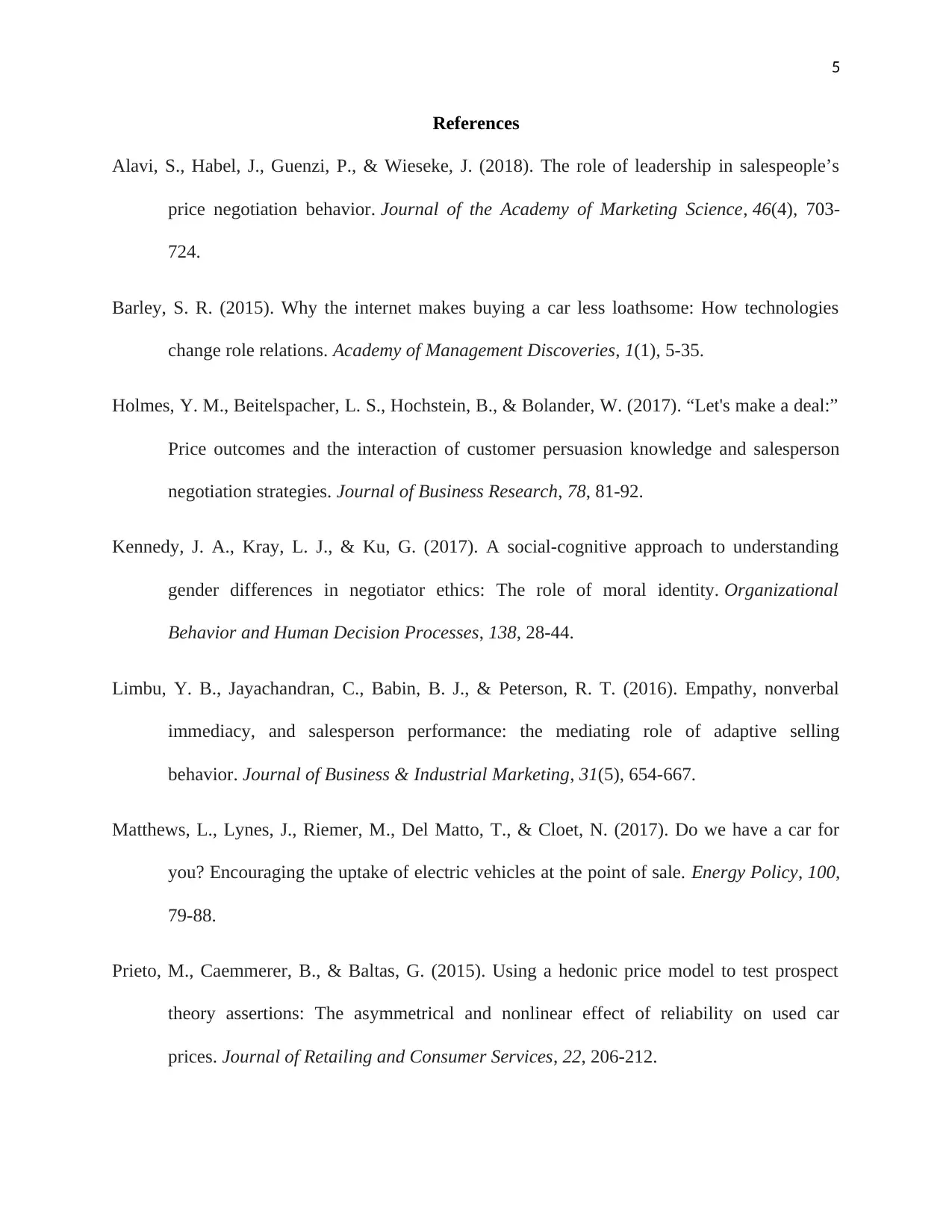
5
References
Alavi, S., Habel, J., Guenzi, P., & Wieseke, J. (2018). The role of leadership in salespeople’s
price negotiation behavior. Journal of the Academy of Marketing Science, 46(4), 703-
724.
Barley, S. R. (2015). Why the internet makes buying a car less loathsome: How technologies
change role relations. Academy of Management Discoveries, 1(1), 5-35.
Holmes, Y. M., Beitelspacher, L. S., Hochstein, B., & Bolander, W. (2017). “Let's make a deal:”
Price outcomes and the interaction of customer persuasion knowledge and salesperson
negotiation strategies. Journal of Business Research, 78, 81-92.
Kennedy, J. A., Kray, L. J., & Ku, G. (2017). A social-cognitive approach to understanding
gender differences in negotiator ethics: The role of moral identity. Organizational
Behavior and Human Decision Processes, 138, 28-44.
Limbu, Y. B., Jayachandran, C., Babin, B. J., & Peterson, R. T. (2016). Empathy, nonverbal
immediacy, and salesperson performance: the mediating role of adaptive selling
behavior. Journal of Business & Industrial Marketing, 31(5), 654-667.
Matthews, L., Lynes, J., Riemer, M., Del Matto, T., & Cloet, N. (2017). Do we have a car for
you? Encouraging the uptake of electric vehicles at the point of sale. Energy Policy, 100,
79-88.
Prieto, M., Caemmerer, B., & Baltas, G. (2015). Using a hedonic price model to test prospect
theory assertions: The asymmetrical and nonlinear effect of reliability on used car
prices. Journal of Retailing and Consumer Services, 22, 206-212.
References
Alavi, S., Habel, J., Guenzi, P., & Wieseke, J. (2018). The role of leadership in salespeople’s
price negotiation behavior. Journal of the Academy of Marketing Science, 46(4), 703-
724.
Barley, S. R. (2015). Why the internet makes buying a car less loathsome: How technologies
change role relations. Academy of Management Discoveries, 1(1), 5-35.
Holmes, Y. M., Beitelspacher, L. S., Hochstein, B., & Bolander, W. (2017). “Let's make a deal:”
Price outcomes and the interaction of customer persuasion knowledge and salesperson
negotiation strategies. Journal of Business Research, 78, 81-92.
Kennedy, J. A., Kray, L. J., & Ku, G. (2017). A social-cognitive approach to understanding
gender differences in negotiator ethics: The role of moral identity. Organizational
Behavior and Human Decision Processes, 138, 28-44.
Limbu, Y. B., Jayachandran, C., Babin, B. J., & Peterson, R. T. (2016). Empathy, nonverbal
immediacy, and salesperson performance: the mediating role of adaptive selling
behavior. Journal of Business & Industrial Marketing, 31(5), 654-667.
Matthews, L., Lynes, J., Riemer, M., Del Matto, T., & Cloet, N. (2017). Do we have a car for
you? Encouraging the uptake of electric vehicles at the point of sale. Energy Policy, 100,
79-88.
Prieto, M., Caemmerer, B., & Baltas, G. (2015). Using a hedonic price model to test prospect
theory assertions: The asymmetrical and nonlinear effect of reliability on used car
prices. Journal of Retailing and Consumer Services, 22, 206-212.
⊘ This is a preview!⊘
Do you want full access?
Subscribe today to unlock all pages.

Trusted by 1+ million students worldwide

6
Sallee, J. M., West, S. E., & Fan, W. (2016). Do consumers recognize the value of fuel
economy? Evidence from used car prices and gasoline price fluctuations. Journal of
Public Economics, 135, 61-73.
Sallee, J. M., West, S. E., & Fan, W. (2016). Do consumers recognize the value of fuel
economy? Evidence from used car prices and gasoline price fluctuations. Journal of
Public Economics, 135, 61-73.
1 out of 7
Your All-in-One AI-Powered Toolkit for Academic Success.
+13062052269
info@desklib.com
Available 24*7 on WhatsApp / Email
![[object Object]](/_next/static/media/star-bottom.7253800d.svg)
Unlock your academic potential
Copyright © 2020–2025 A2Z Services. All Rights Reserved. Developed and managed by ZUCOL.


